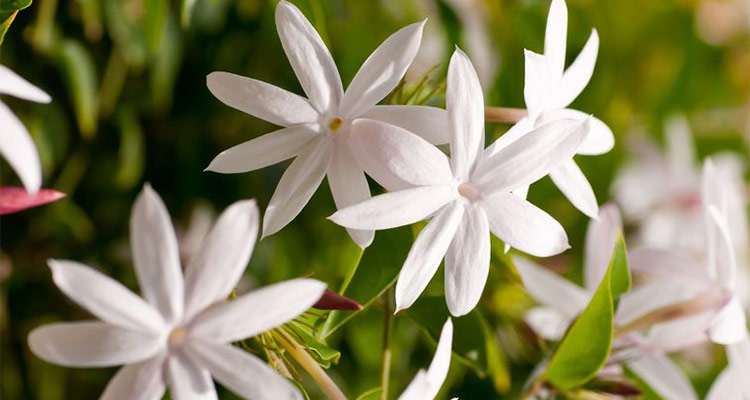Jasmine Absolute
Jasminum grandiflorum or Jasminum sambac

Description
Jasmine Absolute has an exquisitely floral aroma that is uniquely its own.

Jasmine blossoms cannot be effectively steam distilled, so they are extracted by solvent to create a highly concentrated absolute. A tiny bit goes a very long way.
Jasmine Absolute is used within precious fragrancing applications for both men and women.
It is uplifting and has been used to help combat depression. Jasmine Absolute is considered an aphrodisiac. Other uses and benefits can be found below.

Jasmine Absolute Benefits and Uses
- Depression
- Dry Skin
- Exhaustion
- Labor Pains
- Sensitive Skin
Source: Julia Lawless, The Encyclopedia of Essential Oils (Updated Edition) (London: Harper Thorsons, 2014), 596.
Botanical Name
Jasminum grandiflorum or Jasminum sambac
Plant Family
Common Method of Extraction
Solvent Extracted
What is an Absolute?
Plant Part Typically Used
Color
Deep Brown with a Golden Tinge
Consistency
Medium
Perfumery Note
Middle
Strength of Initial Aroma
Strong
Aromatic Description
Jasmine Absolute smells deep, rich, floral and exotic.
Major Constituents
- Benzyl acetate
- Benzyl benzoate
- Phytol
- Squalene 2,3-oxide
- Isophytol
- Phytyl acetate
- Linalool
- Squalene
- Geranyl linalool
- Indole
- (Z)-Jasmone
- Eugenol
See Essential Oil Safety for a more complete list of typical constituents.
Source: F. Bassett, Journees de Digne. Le Jasmin, la Fleur Le Roi. (Parfums Cosmetiques Aromes 119, 1994), 58-64. Source cited in Robert Tisserand and Rodney Young, Essential Oil Safety (Second Edition. United Kingdom: Churchill Livingstone Elsevier, 2014), 312.
Jasmine Absolute Safety Information
Tisserand and Young indicate that there is moderate risk of skin sensitization when using Jasmine Absolute topically, and they recommend a dermal maximum of 0.7%. "Jasmine absolute appears to be a moderate-risk skin sensitizer that has caused problems in 0-1.2% of people with dermatitis when patch tested at 2 or 3%." Adulterants may potentially be the cause of some of the reported sensitization. Reading Tisserand and Young's full profile is recommended. [Robert Tisserand and Rodney Young, Essential Oil Safety (Second Edition. United Kingdom: Churchill Livingstone Elsevier, 2014), 311-313.]
Some may experience an allergic reaction to Jasmine Oil. [Julia Lawless, The Illustrated Encyclopedia of Essential Oils (Rockport, MA: Element Books, 1995), 155.]
Jasmine CO2 Supercritical Select Extract (Jasmine grandiflorum and Jasmine sambac)
In addition to being available as an essential oil, this botanical is available from a small number of reputable sources as a CO2 extract. CO2 extracts offer many advantages. However, they can have differing safety precautions than essential oils because the natural chemistry of CO2 extracts can differ from their essential oil counterparts. Not much safety information is documented from trusted sources for CO2 extracts. Use CO2 extracts with great care and do not assume that every CO2 extract has the same safety precautions as its essential oil counterpart.
General Safety Information
Do not take any oils internally and do not apply undiluted essential oils, absolutes, CO2s or other concentrated essences onto the skin without advanced essential oil knowledge or consultation from a qualified aromatherapy practitioner. For general dilution information, read AromaWeb's Guide to Diluting Essential Oils. If you are pregnant, epileptic, have liver damage, have cancer, or have any other medical problem, use oils only under the proper guidance of a qualified aromatherapy practitioner. Use extreme caution when using oils with children and be sure to first read the recommended dilution ratios for children. Consult a qualified aromatherapy practitioner before using oils with children, the elderly, if you have medical issues or are taking medications. Before using this or any essential oil, carefully read AromaWeb's Essential Oil Safety Information page. For in-depth information on oil safety issues, read Essential Oil Safety by Robert Tisserand and Rodney Young.
Shelf Life
Important Information About the Profiles
The essential oil information provided on AromaWeb is intended for basic educational purposes only. The references to safety information, test results, constituents and percentages is generalized information. Essential oils can vary greatly in composition. The data is not necessary complete and is not guaranteed to be accurate. The essential oil photos are intended to represent the typical and approximate color of each essential oil. However, essential oil composition and color can vary based on harvesting, distillation, age of the essential oil and other factors. Profiles for several CO2 Extracts and absolutes are included within the directory, and are denoted as such.
